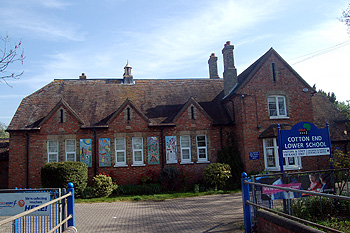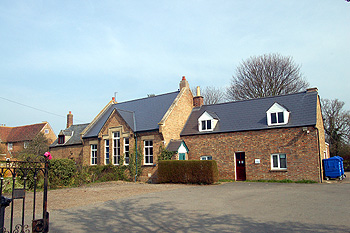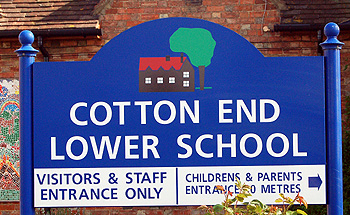Cotton End School

Cotton End Lower School April 2011
On 14th November 1873 the Eastcotts (Cotton End) School Board was formed. Not long afterwards Cotton End had its school, the logbook [SDEastcotts1] stating that it opened on 26th January 1874 though, as we shall see, it was not in the current school buildings..
Bedfordshire and Luton Archives and Records Service office staff have put together a detailed history of the building of the school [CRT130Eastcotts1]. At the first full meeting of the School Board on 4th December 1873 it was resolved that “a temporary School be provided until the new School be erected”. It was proposed to enter into negotiations with the Trustees Cotton End Baptist school room adjacent to the Baptist Meeting for temporary use of it. The trustees agreed and rent was £2 per annum. Joseph Leaver was appointed schoolmaster on 8th January 1874 at a salary of £60 per annum plus lodging expenses. On 22nd January it was agreed that Leaver be empowered to appoint three monitors at sixpence per week each and a lad to sweep the school at threepence per week. School fees were to be a penny per week for the children of labourers and children to be at least five years old before admission.
The School Inspectors report for 1874 was very promising: “This is a new school in a village where there has hitherto been no education. The children as might be expected are very backward for their years, but the general order of the school, and the careful character of the instruction now given appears to promise good success” [SDEastcotts 1]
At a meeting on 18th December a letter from Samuel Charles Whitbread was read offering a site for the new school as a gift. On 20th May 1874 Thomas Jobson Jackson of Bedford was appointed as architect. The plans were approved by the Education Department in London in September 1874. The lowest tender was from James Potter of 24 Brereton Road, Bedford at £989/10/- and that was accepted.

The schoolroom at The Old Meeting House March 2011
As the new school was being built it was resolved on 20th September 1875 to furnish it “with Laurie’s patent desks and forms – on condition that the cost shall not exceed that of the ordinary ones by more than five pounds” It was also agreed: “That a Lean-to shed for the Schoolmaster’s Wood and Coal be built behind the Yard Offices – at a cost not exceeding five pounds”. The school opened on 11th October 1875, the log book [SDEastcotts1] reading: “This morning without “flourish of trumpet” or “beat of drum” we entered the new School”. On 15th November forty new scholars were admitted to the new EastcottsBoardSchool, most from Harrowden who had previously been attending CardingtonSchool.
A land mark Education Act was passed in 1902, coming into effect in 1903. It disbanded the School Boards and gave day to day running of education to newly formed Local Education Authorities, usually the county council, as in Bedfordshire. The old Board Schools thus became Council Schools whilst the old National, British and other non-Board schools became known as Public Elementary Schools.
Bedfordshire & Luton Archives & Records Service has a scrapbook of cuttings of visits made to most Bedfordshire Schools by School Inspectors for a period from just before the First World War through the inter-war years [E/IN1/1]. In 1911 the inspector reported that: “Throughout the School good, honest work is done, while tone and discipline are excellent. Some of the seats used by the Infants are without back-rests. This fault, which I regret has not been pointed out before, should be put right without delay”.
The next visit was in 1913 when average attendance was 68: “This village school continues to be conducted in a very satisfactory manner. The Infants are taught with much kindness and care and they do very good work. In all sections of the school for older scholars very creditable work is done and order and tone are excellent”.
The next visit was not until after the First World War. In 1923 average attendance was 82. “This school is going well under a new Head Teacher. The work of the older children was much improved since she came, and still further progress may be expected. The teaching is more stimulating and there is more life than formerly. In the first class Arithmetic, though not yet quite good, is much better than it was. Composition and Writing are good on the whole, and Singing and Drawing, the latter taught by the Assistant Teacher, are both decidedly above the average. The Physical Training of the children is also developing satisfactorily. Speech appears to need still further attention; the children’s answers in Geography and History were not always audible. The young teacher in charge of the lower class is very painstaking, and with some further experience should do quite well. At present this class is a little noisy at times”.
“In the Infants’ Class order was not altogether satisfactory on the day of the inspection; the children were somewhat inattentive and noisy. The regular teacher of the class, however, was absent and had a long period of absence last year also. Progress in Reading is uneven; some children read well, others are quite backward. Writing is satisfactory and Number seems taught along the right lines. The class makes a less favourable impression than the other two, in which there is much that is promising”.
In 1924 the inspector reported: “There is little change to report in the general condition of the older scholars of this School. All that need be said is that the young teacher in charge of the lower class has made good progress since the last report was written and is doing very useful work”. The infants’ teacher had returned and “the Class made a thoroughly favourable impression”. The next visit was made in 1927: “This school did very good work under the last Permanent Head Teacher. The changes of Headship in the interval between her resignation and the appointment of the present Head unsettled the children in some degree, but the work is now well in hand. In the Infants’ room much creditable work is done, and in the top class there are several children who are doing good written English. The Middle Section, under the care of an inexperienced Teacher who is going to college in September, are not losing ground materially but it would be advisable to appoint a mistress with rather more experience in the management of more than one section when the time comes”.
1930 saw the next visit by the Inspector, when average attendance was 90: “This school has always, up to the present, been a self-contained entity. It is proposed in future to make it a JuniorSchool. The past history of the school, as it stands now, is that it had a period of great success: followed by a period of success, as far as individuals were concerned, in the upper part of the school: varying as regards the junior section; but constant as regards the Infants. This state continues in the Infants’ Section where the same mistress is still the Teacher: in the Middle Section there is a Mistress, not inefficient, but rather ineffective. In the top class the present Head Teacher has done good work. Owing to the limitations of the section in the middle of the school she has had no easy task. But, without praising the “results” as found in her examinations, and not disparaging her own general estimate of the state of the school, it may be fairly said that her work has definitely raised the standard in the top class, and she seems to be a teacher of sound judgment, who would be a valuable Head for Senior Girls, or for Juniors”.
By 1934 there had been some changes: “During the past two years many children of 5 years old have been admitted to this well conducted school, with the result that the lowest class would have to be overlarge if children were not pushed up to prevent this. As it is there are 42 in the Infants’ room, some of which will have to make room for further admissions after Christmas. Fortunately many of them seem to be of a very intelligent type, and the Head Mistress manages to keep them all progressively occupied. They are moved from class to class in oral subjects, and are grouped in written work. The books show clear evidence of progress; the Singing is clear and tuneful; and the pains taken to obtain good speech deserve special mention. The teachers may be congratulated on the condition of the school”.
The final inspection in the book came in 1937, with average attendance 82. “At this visit there were 98 children on the school registers, 70 of whom are taught by two teachers in one room divided only by a curtain. The infants have a separate room. Neither of these rooms is sufficiently large for the numbers occupying it and training, such as is now expected in a JuniorSchool, involving freedom of movement is thus difficult. The long desks in the infant room are not conducive to good posture and are too heavy for these little ones to move”.
“The children appear happy, well-mannered and give of their best; some creditable work was seen. There have been recent changes in the assistant staff, and it was felt that now conditions have become more favourable an attempt might be made to introduce more modern methods. The suggestions discussed with the Head Teacher were: -
(a) A reorganisation of the two upper classes only for handwork and Needlework, thus leaving the infants undisturbed.
(b) The use of methods that will allow for individual rates of progress, particularly in Arithmetic and Reading.
(c) The preparation of a graded Scheme of Work for Needlework.
(d) A broader use of pictorial aids for such subjects as History, Geography and Nature Study.
The Second World War brought many changes to the school. On 11th September 1939 the logbook noted: “School reopened today. Owing to the outbreak of war no transport is available for the senior children to be taken to their Senior School. They are now attending this school which has become a full range school. No supply teacher has been sent this week and about 80 children have been taught by one person. It has been impossible to work to a timetable”. (SDEastcotts4) The logbooks also record the changes to the school to protect it and make safe air-raid shelters for the children. They show the disruption to lessons through practices and genuine warnings.
The third of the great Education Acts was that of 1944 which established the principle of County Primary Schools for children up to the age of 11, at which time they took an examination to determine the nature of the secondary school they would attend until they were 15, the most academically able going to grammar schools, the rest to secondary or secondary modern schools. The act also created two types of successor to the public elementary schools - the Voluntary Aided and Voluntary Controlled schools. Voluntary Aided schools are those in which the Local Education Authority funds the school but the governing body is independent, they are usually Anglican or Roman Catholic schools. Voluntary Controlled schools own their own buildings whilst the staff are employed directly by the governors. Eastcotts became a County Primary School and changed its name to Cotton End County Primary School when another school in the parish was opened at Shortstown in 1957.
In the 1970s Bedfordshire County Council introduced comprehensive education, doing away with the 11+ examination and grammar schools and introducing a tier of school between the old County Primary and County Secondary Schools. Thus Lower Schools now taught children aged 4 to 9, Middle Schools from 9 to 13 and Upper Schools from 13 onwards. Cotton End duly became a Lower School which it remains at the time of writing and still in the 1875 premises [2011] though the Local Education Authority is now the unitary council of Bedford Borough on the abolition of the county council on 1st April 2009.
